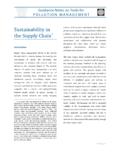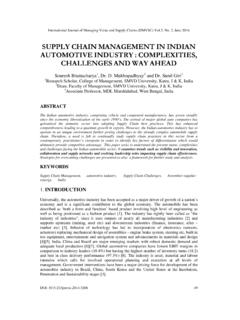Transcription of R&D supply chain strategy - Project SIGMA
1 chain Strategyand EvaluationFirst ReportProfessor Martin Charter, Aleksandra Kielkiewicz-Young, Alex Young, Andrew HughesThe Centre for Sustainable DesignJanuary 2001 The SIGMA Project - 2001 supply chain strategy and authors wish to thank all the organisations and people who freely gave their time to help with thisresearch. The SIGMA Project - 2001 supply chain strategy and SummaryKey findingsThis research investigated the economic, social and environmental impacts in supply chain management(SCM), and how different organisations are addressing the issues of sustainable development.
2 The mainfindings of the research were: There is a lack of clarity in the definitions and scope of the terminology used in SCM and sustainableSCM. Definitions of supply chain , demand chain and value chain are sometimes used interchangeably,although there are differences. Similarly, logistics is often substituted for SCM . The term sustainable supply chain management (SSCM) is not in common usage and there isconsiderable lack of clarity due to misunderstandings on the meaning and scope of the term sustainable . Most organisations have concentrated their SCM efforts on environmental issues environmentalSCM , supply chain environmental management or green procurement .
3 These definitions depend onthe scope of the organisation s understanding of the term supply chain . The most common tools for SSCM have been environmentally based, especially where theenvironmental drivers have been linked to business risk. Social and ethical management strategies have appeared most commonly in the retail sector, wherecustomers consist of the general public and social and ethical issues are more salient due to thephysical association of the product with the supply source. Key factors that have influenced successful SSCM have been the power of companies over the supplychain and the role of business risk drivers in forcing companies to manage risk more effectively into theirsupply chains.
4 However, the key measure of the success of SSCM tools appear to be the amount of buy-in from seniormanagement. Further research is needed to determine a more thorough understanding of successful andunsuccessful SSCM strategies and tools. The SIGMA Project - 2001 supply chain strategy and most advanced techniquesSome of the key management approaches to SCM today include outsourcing of procurement processes,collaborative planning and partnerships between customers and suppliers, and Integrated supply chain (ISC) design, involving all areas of the organisation.
5 These approaches are closely linked to the latestadvances in manufacturing technology including agile manufacturing and postponement technology. Dell,Nokia and Tesco are some of leaders in SCM strategies and with long and complex supply chains, whether they are at the beginning (such as chemicals),in the middle (such as logistics companies), or at the end (retail businesses) of the supply chain , areincreasingly needing to understand sustainability aspects of their supply chains. supply chain sustainabilityissues can range from child labour and exploitation of workers on the one hand to ozone depletion,deforestation and global warming on the other.
6 These issues can be broken down according toenvironmental, social, and ethical aspects. Some of the tools used in sustainable supply chain management(SSCM) include written policies and communications materials, pre-qualification of suppliers (usingenvironmental and/or social/ethical criteria), purchasing guidelines and supplier partnerships. The SIGMA Project - 2001 supply chain strategy and Findings(i)Utilities - water and power companiesThe utilities sector included water and power companies. Analysis of water companies revealed toolsused in environmental procurement such as pre-qualification using software tools, environmentalevaluation questionnaires for sourcing new suppliers and engaging suppliers in environmental issues atcontract stage.
7 Social and ethical issues were not found to be issues that were examined in any companies were involved in supplier dialogue and supplier self-assessment of environmentalissues, while one company promoted ISO4001 as model of best practice of environmental managementfor its partner ventures and interaction with suppliers.(ii) TransportationThe transportation sector was analysed with a focus on automotive, railways and logistics tools found in railway companies included training for procurement -staff in environmental issues,R&D partnerships with suppliers, development of environmental purchasing manuals and supplierenvironmental assessment.
8 Again, there was little evidence of the use of social or ethical managementtools. However, the automotive companies had highly developed relationships with their suppliersincluding requirements for ISO14001 certification, formal partnership programmes for decreasingenvironmental impacts and transferring knowledge to suppliers on environmental best practice. Theautomotive industry encompasses social and ethical issues that need to be addressed within the supplychain, but management tools addressing these were not found. Logistics companies have programmesto manage environmental issues both up the supply chain and down towards their customers, asenvironmental best practice and reverse logistics.
9 (iii) Information, Consumer Electronics and Telecommunications (ICT)Telecommunications companies have developed strong environmental strategies, especially in supplierassessment and evaluation in areas such as risk (including take-back requirements), hazardous materialhandling and continual improvement. There is some integration of these policies into quality controls,but little contribution on social issues. Other tools used included training purchasing and sales staff inenvironmental aspects and supplier co-operation programmes. Consumer electronics firms have had labour rights issues highlighted in global production facilities, buthave developed strong environmental tools driven by legislative and business-to-business (B2B)pressures.
10 Pre-selection and evaluation of suppliers on environmental compliance issues, partneringwith suppliers to influence environmental performance and assisting suppliers to implement EMSthrough loans were other tools identified in this sector. The SIGMA Project - 2001 supply chain strategy and (iv) RetailingThis sector included food, clothing and DIY retailing. All retail segments differed from the other sectorsby including social and ethical issues into SCM , often alongside environmental issues. Food retailersused a number of tools including social and ethical auditing processes of high-risk suppliers on labourand working standards.











